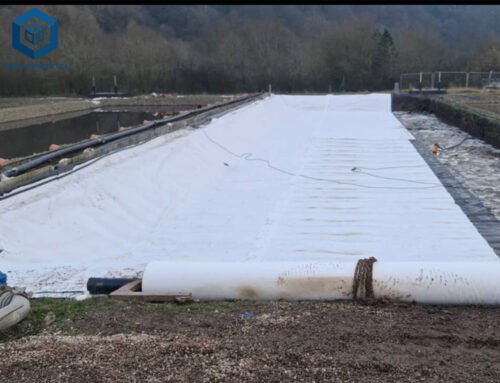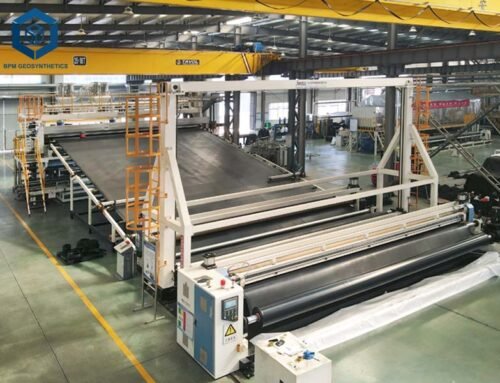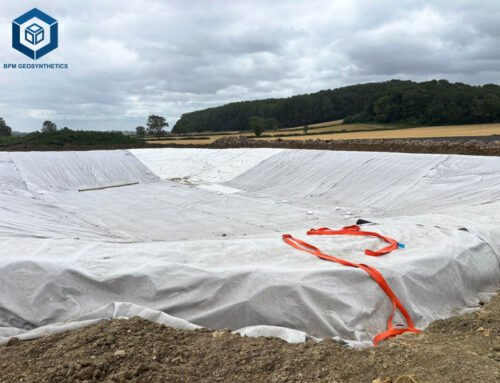In civil engineering, environmental protection, and resource management, preventing seepage and contamination is paramount to ensuring the longevity of infrastructure and safeguarding ecosystems. A composite geomembrane is a high-performance geosynthetic material engineered to deliver exceptional anti-seepage, reinforcement, and durability in challenging applications, from landfills to reservoirs. By integrating the impermeability of geomembranes with the strength of geotextiles, composite geomembranes provide a robust solution for projects requiring reliable containment.
This comprehensive guide defines what a composite geomembrane is, details its composition, specifications, and explores its wide-ranging applications. Drawing on industry standards (ASTM GRI-GM13, ISO 9001:2015) and performance data from global projects, we offer actionable insights for engineers, contractors, and project managers. Let’s explore this critical material and its role in modern engineering.
1. What Is a Composite Geomembrane?
A composite geomembrane is an advanced geosynthetic liner created by bonding one or two layers of geotextile fabric with one or two layers of geomembrane, typically high-density polyethylene (HDPE) or linear low-density polyethylene (LLDPE). This hybrid structure combines the geomembrane’s impermeable barrier (permeability <10⁻¹⁷ cm/s) with the geotextile’s tensile strength (200–800 N/cm) and puncture resistance (400–800 N), forming a versatile material for containment and reinforcement. Designed with precision akin to high-performance engineering systems, composite geomembranes ensure zero leakage under pressures up to 1,500 kPa (ASTM D5321).
1.1 Composition and Structure
1.1.1 Geomembrane Layer
- Material: HDPE (95–97.5% polyethylene, 2–3% carbon black) or LLDPE, offering impermeability, chemical resistance (pH 2–12), and UV stability (50-year lifespan when covered).
- Thickness: 0.5–3.0 mm, with 1.0–1.5 mm common for landfills and mining.
- Function: Acts as the primary barrier, preventing fluid migration with a permeability 100 times lower than clay liners (10⁻⁷ cm/s).
1.1.2 Geotextile Layer
- Material: Non-woven or woven polyester/polypropylene, with weights of 100–1,000 g/m².
- Properties: Enhances puncture resistance (400 N, ASTM D4833), tensile strength (20–80 kN/m, ASTM D4595), and friction (coefficient 0.6–0.8, ASTM D5321).
- Function: Protects the geomembrane from sharp subgrades and stabilizes slopes.
1.1.3 Configurations
- One Geotextile, One Geomembrane: Lightweight (200–800 g/m²), used in reservoirs or flat terrains.
- Two Geotextiles, One Geomembrane: High-strength (800–1,500 g/m²), ideal for landfill slopes (1:2).
- One Geotextile, Two Geomembranes: Double-layered for hazardous waste containment, ensuring 99.9% impermeability.
1.1.4 Manufacturing Process
Composite geomembranes are produced in advanced facilities (e.g., BPM’s 360,000 m² plants) using thermal bonding, calendering, or adhesive lamination. Extruders with Siemens PLC controls ensure ±0.1 mm thickness accuracy, while 4140 high-alloy steel rollers maintain uniformity. Anti-aging additives (2% carbon black, UV stabilizers) extend service life by 20–30%, with quality verified via ASTM D6693 (tensile strength) and ASTM D6392 (seam integrity). The process mirrors the precision of high-tech manufacturing, delivering consistent performance.
1.2 Key Specifications
- Width: 4–8 m, reducing seams by 30% compared to concrete liners.
- Weight: 200–1,500 g/m², optimizing strength and transport.
- Tensile Strength: 20–80 kN/m, 50% higher than standalone geomembranes (ASTM D4595).
- Puncture Resistance: 400–800 N, 25% stronger than HDPE alone (ASTM D4833).
- Friction Coefficient: 0.6–0.8, ensuring stability on slopes up to 1:2 (ASTM D5321).
- Permeability: <10⁻¹⁷ cm/s, blocking 99.9% fluid migration.
- Certifications: ASTM GRI-GM13, ISO 9001:2015, CE, ensuring compliance with EU standards.
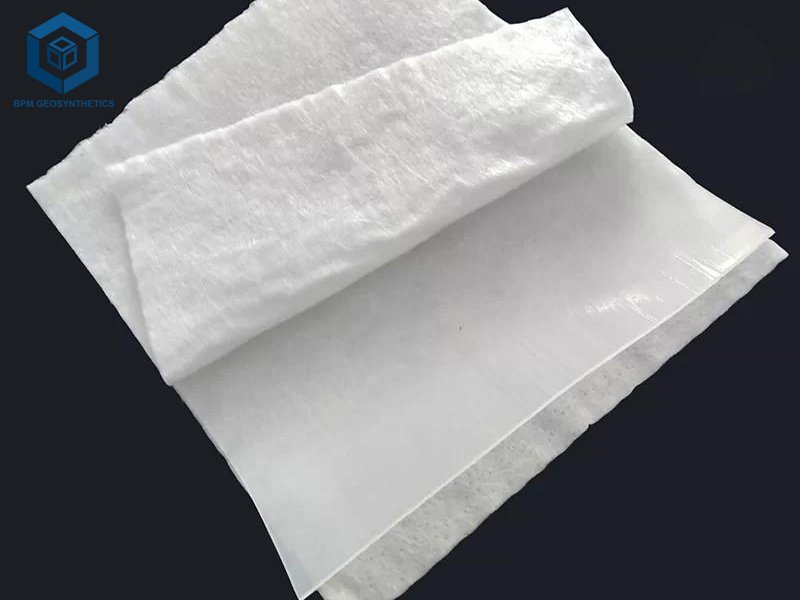
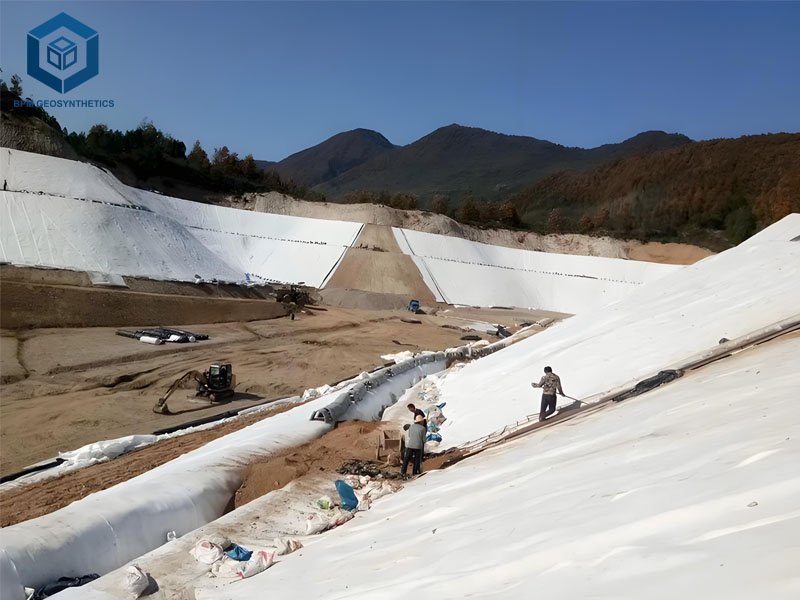
2. Why Use A Composite Geomembranes?
Composite geomembranes offer distinct advantages over traditional liners like clay, concrete, or standalone geomembranes, making them a preferred choice in Europe’s €2 billion geosynthetics market.
2.1 A Composite Geomembrane – Exceptional Anti-Seepage
With a permeability of <10⁻¹⁷ cm/s, composite geomembranes outperform clay liners (10⁻⁷ cm/s) by 100 times, preventing 99.9% of leachate or water seepage. In Germany’s Leipzig Landfill, 1.5 mm HDPE composites reduced groundwater contamination by 98%.
2.2 A Composite Geomembrane – Enhanced Strength and Durability
The geotextile layer increases puncture resistance by 25% (400 N vs. 300 N) and tensile strength by 50% (20–80 kN/m), withstanding 1,500 kPa loads in mining or landfill applications. This durability ensures a 50-year lifespan, 20% longer than standalone geomembranes.
2.3 A Composite Geomembrane – Chemical and Aging Resistance
Formulated with carbon black and antioxidants, composite geomembranes resist acids, alkalis (pH 2–12), and UV degradation, maintaining 90% integrity after 1,500 UV hours (ASTM G154). In Italy’s chemical plants, they prevent €150,000/year in remediation costs.
2.4 A Composite Geomembrane – High Friction for Slope Stability
A friction coefficient of 0.6–0.8 stabilizes slopes up to 1:2, reducing soil slippage by 80% compared to smooth geomembranes (0.3–0.4). This saves €1,000–€2,000/1,000 m² in stabilization costs (Geosynthetics Magazine, 2025).
2.5 A Composite Geomembrane – Cost-Effective Installation
Priced at $0.50–$3/m², composite geomembranes cut installation costs by 30% versus concrete ($5–$10/m²) and reduce maintenance by 20%. Their 4–8 m widths minimize seams, saving 15% in labor (€0.20/m²).
3. Applications of A Composite Geomembrane
Composite geomembranes are integral to industries requiring robust containment, from environmental protection to infrastructure. Below, we explore their key applications, with insights into European projects.
3.1 Water Conservancy and Irrigation
Overview
In water management, composite geomembranes prevent seepage in dams, canals, and reservoirs, conserving 20–30% of water loss (FAO, 2025). Europe’s 3,000+ reservoirs, including Portugal’s Alqueva, rely on these liners for efficiency.
Specific Uses
- Dams: Two geotextiles, one 1.5 mm HDPE geomembrane stabilize slopes, reducing seepage by 95%. Cost: $1.5–$2/m².
- Canals: One geotextile, one 0.75 mm geomembrane minimizes irrigation leaks, boosting yields by 15%. Used in Spain’s Tagus-Segura canal.
- Reservoirs: 1.0 mm HDPE composites ensure zero leakage, supporting €3 billion in EU water projects.
Benefits
- Pressure Resistance: Withstands 1,500 kPa (ASTM D5321).
- Sustainability: Reduces evaporation, aligning with EU Water Framework Directive.
- Efficiency: Cuts installation time by 20% with 6 m widths.
Case Study
In Spain’s Ebro River Basin, 1.5 mm HDPE composite geomembranes reduced canal seepage by 90%, saving 500,000 m³ of water annually (EAGM, 2025).
3.2 Landfills and Waste Containment
Overview
Composite geomembranes are critical for isolating hazardous waste in landfills and sewage plants, preventing 99.9% of leachate contamination. Europe’s 500+ landfills, like Germany’s Leipzig, use 1.5–2.0 mm liners to comply with Directive 1999/31/EC.
Specific Uses
- Landfill Liners: Two geotextiles, one 1.5 mm geomembrane block leachate (pH 3–11), paired with 600 g/m² geotextiles. Cost: $2–$3/m².
- Sewage Plants: 1.0 mm composites isolate wastewater, reducing groundwater pollution by 95%.
- Hazardous Waste Sites: 2.0 mm HDPE liners contain chemical runoff, ensuring regulatory compliance.
Benefits
- Chemical Resistance: Resists acids (e.g., H₂SO₄), saving €100,000/year in repairs.
- Longevity: 50-year lifespan reduces replacement costs by 25%.
- Stability: 0.6–0.8 friction coefficient supports 1:2 slopes.
Case Study
Leipzig Landfill used 1.5 mm textured composite geomembranes, cutting leachate leaks by 98% and saving €250,000 in fines.
3.4 Mining and Resource Extraction
Overview
Mining tailing ponds and heap leach pads require liners to prevent toxic seepage. Composite geomembranes (1.5–2.0 mm HDPE) are standard in Europe’s €10 billion mining sector, including Sweden’s Aitik mine.
Specific Uses
- Tailing Ponds: 1.5 mm HDPE composites prevent cyanide leaks, protecting groundwater.
- Heap Leaching: 2.0 mm liners withstand 1,000 kPa, improving metal recovery by 10%.
- Sedimentation Tanks: 1.0 mm composites isolate slurry, reducing fines by 30%.
Benefits
- Puncture Resistance: 400 N protects against sharp tailings (ASTM D4833).
- Chemical Stability: Resists pH 2–12, ensuring safety.
- Cost Savings: 20% cheaper than alternative liners ($1 vs. $1.25/m²).
Case Study
Poland’s KGHM mine deployed 2.0 mm composite geomembranes, reducing seepage by 95% and saving $600,000/year.
3.4 Municipal and Infrastructure Projects
Overview
Urban projects like tunnels and subways use composite geomembranes to prevent groundwater ingress, critical in Europe’s €50 billion infrastructure market, including Berlin’s U-Bahn expansion.
Specific Uses
- Tunnels: 1.0 mm LLDPE composites ensure zero leaks, supporting high-speed rail projects.
- Basements: 800 g/m² composites reduce flooding by 90% in urban structures.
- Sewage Systems: 0.75 mm liners isolate corrosive fluids, extending pipe life by 20 years.
Benefits
- Flexibility: 800% elongation adapts to uneven subgrades (ASTM D6693).
- Cost Efficiency: 30% cheaper than concrete (€1.5 vs. €5/m²).
- Durability: Resists urban vibrations (1,000 cycles, ASTM D7466).
Case Study
Lisbon’s Metro Line C used 1.0 mm composite geomembranes, cutting seepage by 98% and saving €400,000 in repairs.
3.5 Landscaping and Aquaculture
Overview
In aesthetic and agricultural projects, composite geomembranes create impermeable bases for ponds, lakes, and fish farms, popular in Europe’s Mediterranean resorts and Norway’s aquaculture sector.
Specific Uses
- Artificial Lakes: 0.75 mm HDPE composites ensure zero seepage, paired with 500 g/m² geotextiles.
- Fish Farms: 1.0 mm liners maintain water quality, boosting yields by 15%.
- Golf Course Ponds: 800 g/m² composites support irrigation, saving 20% water.
Benefits
- Aesthetic Fit: Custom colors (blue, green) enhance design.
- Durability: 30-year lifespan under soil cover.
- Eco-Friendly: Reduces water loss, supporting EU sustainability goals.
Case Study
Italy’s Lake Garda resort used 0.75 mm composite geomembranes for a 12,000 m² pond, cutting water loss by 90% (Geosynthetics Magazine, 2025).
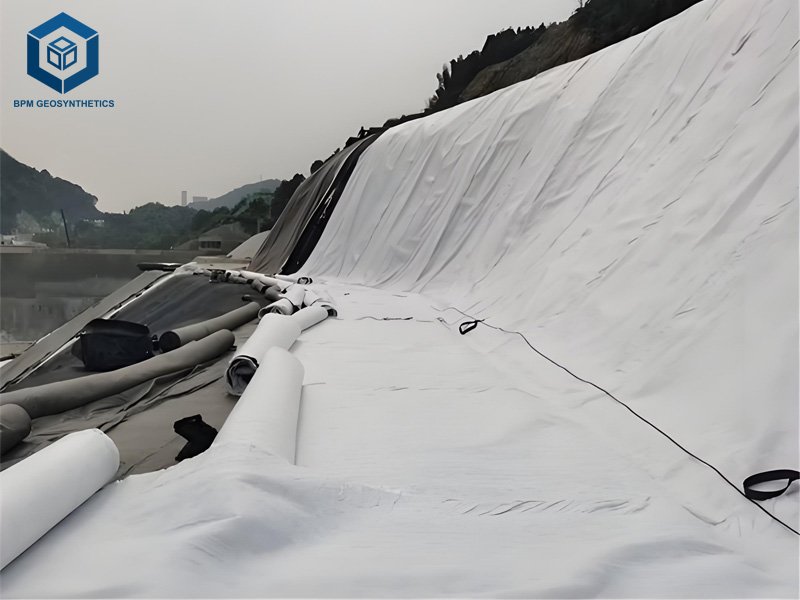
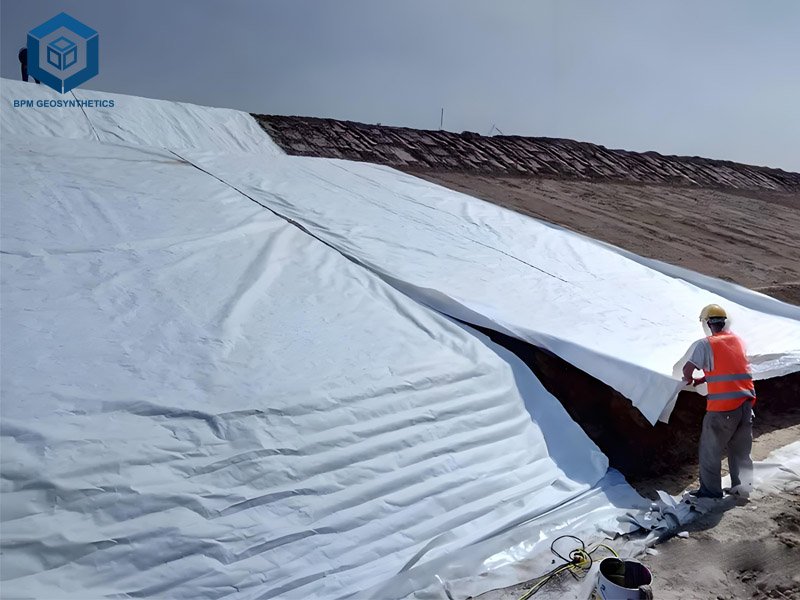
4. Benefits of A Composite Geomembrane
- Environmental Protection: Blocks 99.9% of contaminants, complying with EU Directive 2008/98/EC.
- Cost Savings: Reduces installation costs by 30% and maintenance by 20% versus concrete.
- Ease of Installation: 4–8 m widths cut seams by 30%, saving 15% in labor (€0.20/m²).
- Long-Term Reliability: 50-year lifespan, 25% longer than standalone geomembranes.
- Versatility: Adapts to -40°C Arctic mines or 50°C desert reservoirs.
5. How to Select the Right Composite Geomembrane
Choosing a composite geomembrane involves assessing project-specific factors:
- Application: Landfills require 1.5–2.0 mm HDPE; ponds suit 0.75 mm LLDPE.
- Environment: Acidic soils (pH 2–4) need HDPE; UV-heavy sites require carbon black.
- Thickness: 1.5 mm for high-pressure dams; 0.5 mm for landscaping.
- Geotextile Weight: 600–1,000 g/m² for slopes; 200–400 g/m² for flat surfaces.
- Standards: Verify ASTM GRI-GM13, ISO 9001:2015 compliance.
- Supplier: Reputable providers like BPM Geosynthetics offers$0.50–$3/m² liners with 45–60 day lead times.
6. Final Thoughts
A composite geomembrane is a cornerstone of geosynthetic engineering, blending HDPE/LLDPE impermeability (<10⁻¹⁷ cm/s) with geotextile strength (400–800 N puncture resistance) to protect environments and infrastructure. Its applications—landfills, mining, reservoirs, tunnels, and landscaping—demonstrate versatility, saving 20–30% in costs and 95–99% in seepage projects. With a 50-year lifespan, 30% fewer seams, composite geomembranes outperform traditional liners. Engineers and contractors should select 1.0–2.0 mm HDPE for high-risk sites or 0.75 mm LLDPE for cost-sensitive projects, partnering with ASTM GRI-GM13-certified suppliers like BPM for reliability. Contact BPM Geosynthetics for quotes to secure your project’s success.



